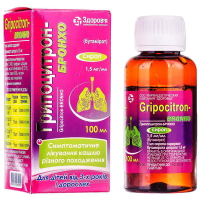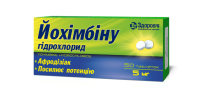GENERAL CHARACTERISTICS
Agents used for coughs and catarrhal diseases. АТС code R05D B13.
Indications to Use:
Symptomatic treatment of cough (including non-productive cough) of various etiologies.
First Aid
-
GENERAL CHARACTERISTICS Non-steroidal anti-inflammatory agents. Propionic acid derivatives. Code АТС М01А Е17. Indications to use: Short-term symptomatic treatment of acute pain from mild to moderate severity, such as musculoskeletal pain, painful menstruation (dysmenorrhea), toothache.$31
-
Digoksin-Zdorovye tablets 0.25 mg blister 50 pcs Дигоксин-Здоровье таблетки по 0,25 мг блистер 50 штGENERAL CHARACTERISTICS Cardiac medications. Cardiac glycosides. Digitalis glycosides. ATC code C01A A05. Indications to Use: Congestive cardiac failure, atrial fibrillation and flutter (for regulation of the heart rate), supraventricular paroxysmal tachycardia.$11
-
GENERAL CHARACTERISTICS Non-steroidal anti-inflammatory and antirheumatic agents. ATC code М01А В55. Indications to Use: The drug should be administered in the following conditions: • aggravation of inflammatory or degenerative forms of rheumatism: rheumatoid arthritis, ankylosing spondylitis, osteoarthritis, spondyloarthritis, vertebral pain syndromes, extra-articular rheumatism; • acute attacks of gout • renal and hepatic colics; • pain, inflammation and swelling after injuries and surgical interventions.$21
-
GENERAL CHARACTERISTICS Agents used topically for joint and muscle pain. NSAID for topical use. Diclofenac. ATC code М02А А15. Indications to Use: Local treatment of pain and inflammation of joints, muscles, ligaments and tendons of rheumatic or traumatic origin.$21
-
GENERAL CHARACTERISTICS Agents used topically for joint and muscle pain. NSAID for topical use. Diclofenac. ATC code М02А А15. Indications to Use: Local treatment of pain and inflammation of joints, muscles, ligaments and tendons of rheumatic or traumatic origin.$13
-
GENERAL CHARACTERISTICS Agents used topically for joint and muscle pain. NSAID for topical use. Diclofenac. ATC code М02А А15. Indications to Use: Local treatment of pain and inflammation of joints, muscles, ligaments and tendons of rheumatic or traumatic origin.$11
-
GENERAL CHARACTERISTICS Antifungals for topical use. ATC Code D01A E22. Indications to Use: Local treatment of fungal infections caused by naphthyfin-sensitive pathogens, such as: – fungal infections of skin and skin folds; – interdigital mycoses; – fungal infections of the nails (onychomycosis) – cutaneous candidiasis; – chromophytosis; – inflammatory dermatomycosis accompanied or not accompanied by itching.$17
-
GENERAL CHARACTERISTICS Antifungals for topical use. ATC Code D01A E22. Indications to Use: Local treatment of fungal infections caused by naphthyfin-sensitive pathogens: – fungal infections of skin and skin folds; – interdigital mycoses; – fungal infections of the nails (onychomycosis) – cutaneous candidiasis; – chromophytosis; – inflammatory dermatomycosis; – otomycosis.$22
-
GENERAL CHARACTERISTICS Non-steroidal anti-inflammatory agents. Propionic acid derivatives. ATC code М01А Е01. Indications to Use: Symptomatic therapy of headache and toothache, dysmenorrhea, neuralgia, back pain, joint pain, muscle pain, rheumatic pain, and cold and flu symptoms.$11
-
GENERAL CHARACTERISTICS Agent acting on the respiratory system. Drugs used for diseases of the throat. Antiseptics. ATC code R02A А20. Indications to Use: Local treatment of infectious and inflammatory diseases of ENT organs and oral mucosa (tonsillitis, pharyngitis, laryngitis, recurrent oral and aphthous stomatitis.$11
-
GENERAL CHARACTERISTICS Agent acting on the respiratory system. Drugs used for diseases of the throat. Antiseptics. ATC code R02A А20. Indications to Use: Local treatment of infectious and inflammatory diseases of ENT organs and oral mucosa (tonsillitis, pharyngitis, laryngitis, recurrent oral and aphthous stomatitis.$11
-
GENERAL CHARACTERISTICS Agent acting on the respiratory system. Drugs used for diseases of the throat. Antiseptics. ATC code R02A А20. Indications to Use: Local treatment of infectious and inflammatory diseases of ENT organs and oral mucosa (tonsillitis, pharyngitis, laryngitis, recurrent oral and aphthous stomatitis.$11
-
GENERAL CHARACTERISTICS Dermatological agents. Antibiotics and chemotherapeutic agents, combinations. ATC code D06C. Indications to Use: In surgical practice – the drug is used to treat purulent wounds in phase I (purulent-necrotic) of the wound process, to prevent purulence of superficial and deep wounds, in postoperative complications (postoperative wound suppuration, phlegmon, fistula, abscess) in combustiology – for prevention and treatment of suppuration in burn wounds; in dermatology – for treatment of purulent-inflammatory dermal diseases (pyoderma).$35
-
GENERAL CHARACTERISTICS Agents used for erectile dysfunction. Yohimbine. ATC code G04B E04. Indications to Use: Erectile dysfunction of various etiologies.$18
-
GENERAL CHARACTERISTICS Agents for use in dentistry. ATC code А01A D11. Indications to Use: Treatment of mild forms of gingival lesions and the oral mucosa, infectious genesis of the lips with formation of vesicles, gingivitis and glacial erythema. Symptomatic treatment of irritation, hypersensitivity and/or mucous membrane irritation due to the use of a denture. Prevention of pain and discomfort caused by teething. Reduction of irritation and discomfort caused by orthodontic procedures.$13
-
GENERAL CHARACTERISTICS Cardiac medications. Trimetazidine. ATC code С01Е В15. Indications to Use: Trimetazidine is prescribed for adults for a symptomatic treatment of stable angina with insufficient effectiveness or intolerance of first line antianginal drugs.$13
-
GENERAL CHARACTERISTICS Cardiac medications. Trimetazidine. ATC code С01Е В15. Indications to Use: Trimetazidine is prescribed for adults for a symptomatic treatment of stable angina with insufficient effectiveness or intolerance of first line antianginal drugs.$27
-
GENERAL CHARACTERISTICS Antiarrhythmic agents of Class III. ATC code С01В D01. Indications to Use: Preventative medication for: – ventricular tachycardia, which poses a threat to the life of the patient: treatment must begin in a hospital setting with constant monitoring of the patient’s condition; – symptomatic ventricular tachycardia (documented), which leads to disability; – supraventricular tachycardia (documented), which requires treatment, and in cases where other drugs have no therapeutic effect or are contraindicated; – ventricular fibrillation. Treatment of supraventricular tachycardia: slowing or decreasing of fibrillation or auricular flutter. Ischemic heart disease and/or left ventricle malfunction (see the Pharmacodynamics section.)$11
-
GENERAL CHARACTERISTICS Non-steroidal anti-inflammatory drugs for topical application. ATC code М02А А10. Indications to Use: Post-traumatic pain in muscles and joints, inflammation of tendons.$15
-
GENERAL CHARACTERISTICS Antiarrhythmic agents of Class III. ATC code С01В D01. Indications to Use: Preventative medication for: – ventricular tachycardia, which poses a threat to the life of the patient: treatment must begin in a hospital setting with constant monitoring of the patient’s condition; – symptomatic ventricular tachycardia (documented), which leads to disability; – supraventricular tachycardia (documented), which requires treatment, and in cases where other drugs have no therapeutic effect or are contraindicated; – ventricular fibrillation. Treatment of supraventricular tachycardia: slowing or decreasing of fibrillation or auricular flutter. Ischemic heart disease and/or left ventricle malfunction (see the Pharmacodynamics section.)$11
-
GENERAL CHARACTERISTICS Corticosteroids for use in dermatology. High potency corticosteroids (Group IV). Clobetasol. АТС code D07A D01. Indications to Use: Psoriasis (except for common plaque psoriasis), persistent eczema, lichen planus, discoid lupus erythematosus and other skin diseases that do not respond to treatment with less potent GCS.$15
-
GENERAL CHARACTERISTICS Corticosteroids for use in dermatology. High potency corticosteroids (Group IV). Clobetasol. ATC code D07A D01. Indications to Use: Psoriasis (except for common plaque psoriasis), persistent eczema, lichen planus, discoid lupus erythematosus and other skin diseases that do not respond to treatment with less potent GCS.$15
-
GENERAL CHARACTERISTICS Quinolone antibacterials. Fluoroquinolones. Levofloxacin. АТС Code J01M A12. Indications to Use: It is prescribed to adults with infections of mild or moderate severity to treat such infections caused by susceptible to levofloxacin microorganisms: acute sinusitis, exacerbation of chronic bronchitis, pneumonia, complicated and uncomplicated urinary tract infections (including pyelonephritis), skin and soft tissue infections, chronic bacterial prostatitis.$18
-
GENERAL CHARACTERISTICS Anesthetics, Local. Lidocaine. ATC Code N01B В02. Indications to Use: Dentistry and maxillofacial surgery. Anesthesia of the injection site before local anesthesia; anesthesia at opening of superficial abscess, removal of mobile milk teeth and fragments of bones, stitching on mucous membranes. Anesthesia of the gum to fix the dental crown or bridge denture. The drug is used for manual or instrumental scaling or for the treatment of enlarged interdental papillae to reduce or suppress the hypersensitive swallowing reflex. Contouring of the imprint of teeth in wax or placing the X-ray film, the drug can be used only when elastic impression materials are used. The drug can be used in children for frenectomy and removal of salivary gland cysts. Without prescription of superficial benign tumors of the mucous membrane. Otolaryngology. In the case of treatment of nasal bleeding before electrocautery, resection of the septum and resection of nasal polyps. It can be administered apply also before tonsillectomy for suppression of a vomiting reflex and anesthesia of a place of an injection. As additional anesthesia before opening of a peritonsillar abscess or before a puncture of a maxillary sinus. Endoscopic and instrumental researches. Anesthesia of the pharynx before the introduction of various tubes through the nose or mouth (gastroduodenal probe, Sengstaken-Blakemore tube). Replacement of tracheotomy tube. Obstetrics and gynecology. Anesthesia of the perineum for the performance of episiotomy. Removal of stitches. Anesthesia of thesurgical area for vaginal operations or operations on the cervix. Dermatology. Anesthesia of the skin and mucous membranes for small surgical interventions.$31
-
GENERAL CHARACTERISTICS Antivaricose therapy. ATC Code С05В А03. Indications to Use: Treatment of diseases of superficial veins, such as varicose veins, and associated complications, phlebothrombosis, thrombophlebitis, superficial periphlebitis. Postoperative varicose phlebitis, complications after surgical removal of the saphenous vein of the leg. Injuries and bruises, infiltrates and localized edema, subcutaneous hematomas. Injuries and stretch of the muscle-tendon and capsule-ligament structures.$31
-
GENERAL CHARACTERISTICS Antipropulsives. ATC Code А07D A03. Indications to Use: Symptomatic treatment of acute diarrhea in adults and children over 12 years. Symptomatic treatment of acute episodes of diarrhea due to irritable bowel syndrome in adults aged 18 years after the initial diagnosis by a doctor.$12
-
GENERAL CHARACTERISTICS ANTIHISTAMINES FOR SYSTEMIC USE ATC Code R06A X13. Indications to Use: Symptomatic treatment of allergic rhinitis and chronic idiopathic urticaria in adults and children over 2 years.$11
-
GENERAL CHARACTERISTICS ANTIHISTAMINES FOR SYSTEMIC USE ATC Code R06A X13. Indications to Use: Symptomatic treatment of allergic rhinitis and chronic idiopathic urticaria.$11
-
GENERAL CHARACTERISTICS Vitamin B complex with minerals. ATC Code А11Е С. Indications to Use: Symptomatic treatment of magnesium deficiency in the body. This medicine contains magnesium. The combination of several of the following symptoms may indicate a deficiency of magnesium in the body: – increased excitability, irritability, anxiety, transient weakness, minor sleep disorders; – signs of anxiety, manifested by gastrointestinal spasms or increased heart rate (in the absense of heart disease); – muscle cramps, tingling sensation in the muscles. Prescription of magnesium can help reduce or eliminate these symptoms. If the symptoms do not decrease after a month of administration of the drug, the continuation of the treatment is not advisable.$25






























